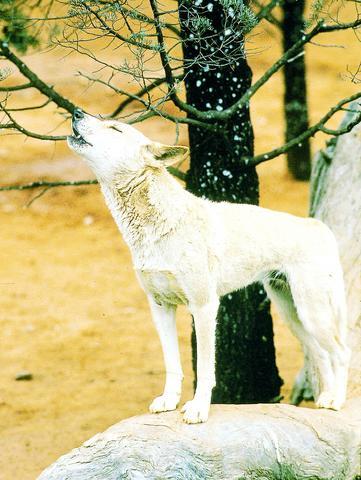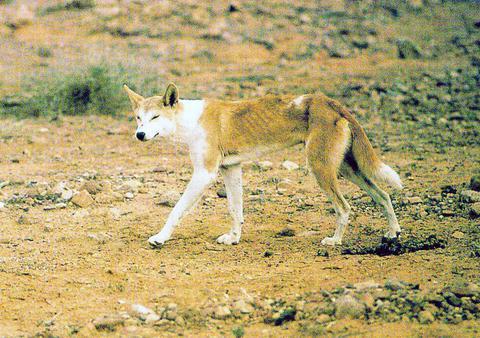Wild dogs are winning a battle for territory in the remote Australian bush, overrunning protected areas to attack stock behind a massive dingo fence which has defended populated areas for 100 years.
Practically invisible in the scrubby bush, the dogs are moving in as some graziers give up the fight, with Australia's sheep numbers down to their lowest in 50 years because of drought.

PHOTO: REUTERS
Sudden hot spots of wild dogs have become as great a problem for many farmers as the worst drought in a century, with attacks by native dingoes and savage crossbreeds taking out 20 percent or more of sheep flocks in some areas.

PHOTO: REUTERS
Nobody knows how many dogs are there. It could be millions.
"Many, many, many. The population has increased enormously. The big worry is they're increasing," farmer Robert Pietsch said.
Pietsch, president of the sheep and wool division of farmers group AgForce, says the dog explosion has now spread throughout Queensland and across vast distances into Western Australia, Victoria, New South Wales and South Australia.
This covers most of the barren central Outback of a country almost as big as the US.
Australia's famous dingo fence, a 180 cm-high wire mesh barrier which runs for 6,000km from central Queensland through NSW and South Australia to the Great Australian Bight, keeps most dogs on its unpopulated side.
But even this massive silent symbol of Australia's battle with its land -- a fence twice as long as the Great Wall of China -- is feeling the strain of exploding dog numbers on both of its sides.
The problem has become so great that some farmers say a poisoning, trapping and shooting campaign might need to be on such a great scale that it could make the fence irrelevant, just as work finishes on a 20-year re-building campaign.
Jerry Stanley, the Department of Natural Resources and Mines officer in charge of maintaining the Queensland section of the fence at a cost of A$1.6 million a year (US$1 million), uncomfortably defends the fence in his backyard office in Roma.
A dominant Outback man with a sweat-stained hat fixed above piercing eyes and dusty bushman's clothes, Stanley would rather be in the bush than talking about the politics of the fence.
"We've got a beautiful ... a good fence out there, an excellent fence. I believe its running at about 90-95 percent dog proof," he said. "Hot spots and people that don't bait are the problem."
But mauled sheep, their white fleece smeared red with blood, dead in fields or limping with horrifying gashes on their sides or hind quarters, are an increasing sight.
"They're driving people out of the industry. People can't stay because they'll just be eaten out," Pietsch said.
Authorities are spreading massive amounts of a poison known as 10/80, made from the foul-smelling Australian native gidgee tree. But it is not enough. Pietsch wants to form syndicates and produce strategic plans.
Stanley, who has spent the last 21 years travelling the barrier and stalking "vermin," laconically says co-ordination is needed or dogs move from one property to the next.
Old problem
This is a worsening of a dog problem which has been growing in Australia for a very long time.
Wolflike reddish-brown dogs, dingoes, were introduced to the fragile Australian ecology, probably by migrating Aborigines up to 60,000 years ago. They breed only a couple of times a year.
But increasing cross-breeding between dingoes and dogs introduced by European settlers is accelerating reproduction of wild dogs, creating large packs.
This is being accompanied by a decline of Australia's sheep flock to less than 100 million from its peak of 173 million in 1990 because of a collapse in wool prices and severe drought.
Farmers have less area to defend and less to spend on their half-share of the annual fence cost.
Meanwhile, the battle between dogs, sheep and fence is fought mostly out of sight around a construction which grew from rabbit fences built in the 1880s.
"We don't see a lot of dogs on the fence. We probably shoot 20 or 30 dogs a year. That's not a lot when you're doing three quarters of a million kilometers a year," said Stanley, whose 22 men and 12 Landcruisers cover the 2,500km fence every week.
"Dogs aren't stupid," he said.

Exceptions to the rule are sometimes revealing. For a brief few years, there was an emerging ideological split between the Democratic Progressive Party (DPP) and Chinese Nationalist Party (KMT) that appeared to be pushing the DPP in a direction that would be considered more liberal, and the KMT more conservative. In the previous column, “The KMT-DPP’s bureaucrat-led developmental state” (Dec. 11, page 12), we examined how Taiwan’s democratic system developed, and how both the two main parties largely accepted a similar consensus on how Taiwan should be run domestically and did not split along the left-right lines more familiar in

As I finally slid into the warm embrace of the hot, clifftop pool, it was a serene moment of reflection. The sound of the river reflected off the cave walls, the white of our camping lights reflected off the dark, shimmering surface of the water, and I reflected on how fortunate I was to be here. After all, the beautiful walk through narrow canyons that had brought us here had been inaccessible for five years — and will be again soon. The day had started at the Huisun Forest Area (惠蓀林場), at the end of Nantou County Route 80, north and east

Specialty sandwiches loaded with the contents of an entire charcuterie board, overflowing with sauces, creams and all manner of creative add-ons, is perhaps one of the biggest global food trends of this year. From London to New York, lines form down the block for mortadella, burrata, pistachio and more stuffed between slices of fresh sourdough, rye or focaccia. To try the trend in Taipei, Munchies Mafia is for sure the spot — could this be the best sandwich in town? Carlos from Spain and Sergio from Mexico opened this spot just seven months ago. The two met working in the

This month the government ordered a one-year block of Xiaohongshu (小紅書) or Rednote, a Chinese social media platform with more than 3 million users in Taiwan. The government pointed to widespread fraud activity on the platform, along with cybersecurity failures. Officials said that they had reached out to the company and asked it to change. However, they received no response. The pro-China parties, the Chinese Nationalist Party (KMT) and Taiwan People’s Party (TPP), immediately swung into action, denouncing the ban as an attack on free speech. This “free speech” claim was then echoed by the People’s Republic of China (PRC),